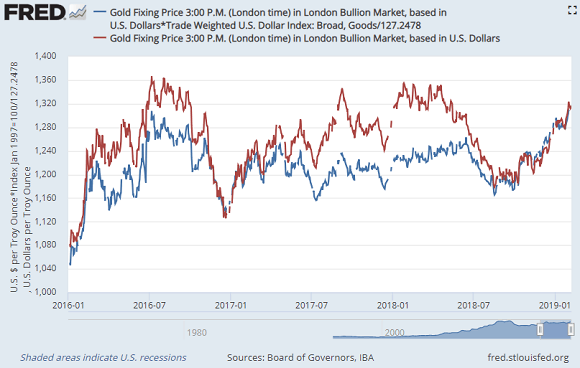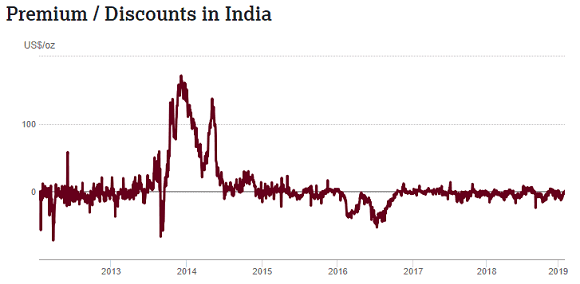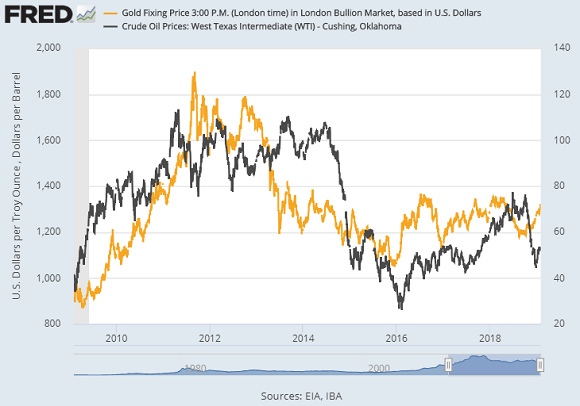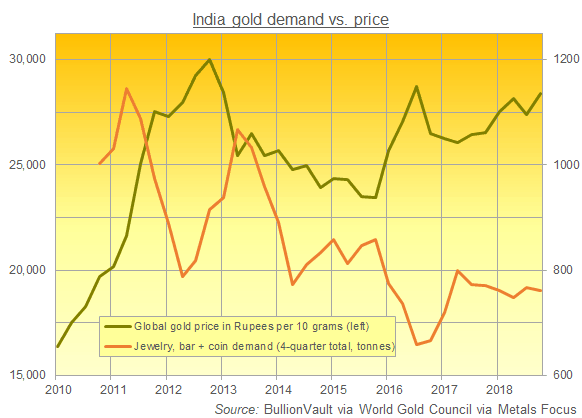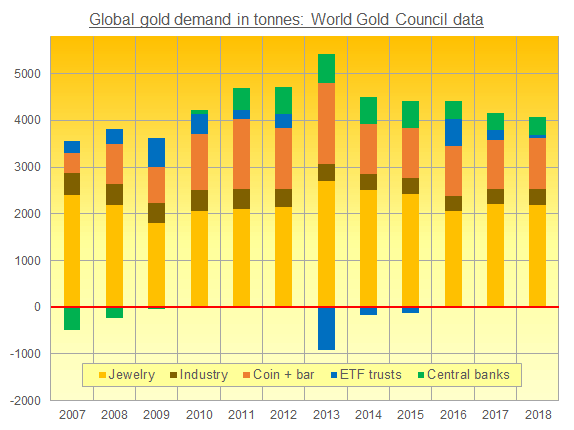After an initial run up above USD $1390 per ounce earlier in the week, gold prices have been in correction mode, shedding nearly $40 per ounce to sit at USD $1354 (6pm Sydney time, 19th March 2014).
The pullback was not unexpected, as despite the hand slapping sanctions placed on a handful of Russian officials by the EU and the US, the situation still looks broadly in control there, although Putin signing an executive order recognising Crimea as a sovereign state and stating its earlier annexation was unlawful will have raised some eyebrows.
Over the weekend of course the Crimeans voted and it was almost unanimous that the majority of Crimeans wish to re-join Russia, with some 95% of Crimeans supporting the referendum, and that was based off a voter turnout of nearly 80%.
Even Kim Jong-Un in North Korea would be happy with that kind of endorsement.
Unsurprisingly, as stated above there was some noise from the UK, the EU and the US, saying that they won’t recognise the legitimacy of the referendum, but at the end of the day it’s a stretch to believe this will degenerate into a shooting war, and the importance of Russian gas to the European economy is known to all, as is the importance of the spending habits of the Russian plutocracy in London.
As such, now that this referendum is out of the way, things have calmed down a little and this is no doubt one of the reasons we’ve seen weakness in the gold price these last few days (as well as a rally in equities)
Golden cross coming?
Despite the correction these past 48 hours, the yellow metal is at an interesting technical standpoint right now, with its 50 day moving average (DMA) and 200 DMA only about $10 apart.
The 200 DMA was at USD $1342 at the end of the year, so we’re already above that, and it has since trended down to the USD $1300 mark (the 200DMA, not the spot price).
Should gold stabilise around these levels and hold above USD $1350 per ounce, these two averages should cross this week, creating a potential “golden cross” signal, which historically has seen a 50% rally in the gold price in the following 15 months.
This would put gold at roughly $2000 by late 2015. Were this to eventuate, then the 2011-2015 period for gold will look eerily similar to the 1974-1978 correction and consolidation in the last major bull market for the metals.
This is based on the last 13 years, and has many bulls salivating, although further weakness in the days ahead can’t be ruled out, especially with analysts entering the week so bullish on the outlook for the yellow metal.
This is usually a great contrarian sell signal and usually a sign a pullback is needed.
Indeed so constructive has the price action been of late that Citi’s FX technical team suggested gold is on its way to USD $1434 an ounce, and should it get above this level, a run into the USD $1600 range should be expected.
Whilst this is of course possible, gold bulls should keep in mind that we’ve had near on 3 months of uninterrupted price gains here. A pullback shouldn’t be unexpected, and an easing of tensions over Crimea is looking like a catalyst.
I hope the uptrend continues, but the rest of March could be a little tricky, especially with the Fed taper likely (it will in all likelihood have been confirmed when you read this)
This is especially so in light of a report from the China Gold Association that first quarter demand is likely to be 50 tonnes less than last year (will still be around 250 tonnes, or 1000 tonnes a year). Shanghai gold exchange premiums have gone into discount of late, so China buying is obviously subdued relative to the frenetic pace of 2013 (its still very high don’t you worry), but from a short term view, this will make a test of USD $1400 per ounce even harder for gold in the short run.
Indeed it will be interesting to see how futures positioning and the technical picture develops over the last couple of days this week.
Is the RBA rate cutting cycle really over?
A couple of weeks ago I penned an article on the outlook for the Aussie economy where the conclusion was that the RBA had erred in dropping its easing bias, and that the boom years were well and truly over.
Whilst not predicting a recession (due to the strength of net exports), it painted a mostly gloomy picture of the economy, with the suggestion that rates will head lower.
Since the release of that report, incoming economic data has beaten market expectations, with many now feeling more confident that we’ve seen the low of the rate cutting cycle, and that the next move is up.
Retail sales have boomed, full time employment numbers were off the charts positive (although the unemployment rate didn’t budge), and GDP figures came in ahead of expectations. Building approvals were very strong too.
Against this, consumer and business confidence has continued to deteriorate, as have business conditions, but the uptick in data has been enough for even Westpac Chief Economist Bill Evans (a known dove and probably the most respected economist from the Big 4 – no disrespect meant against the rest) to change his interest rate outlook, no longer predicting further cuts to the cash rate.
Earlier this week, he literally moved the market (especially the AUD), with his changed forecast, stating that he now thinks we’ve seen the bottom of the interest rate cycle, and that 2.5% marks the low for the cash rate.
As I said earlier he is Australia’s most respected bank economist, and led the way in calling for much lower rates than his counterparts, so his point of view is worth a lot of weight in the marketplace (deservedly).
He primarily pointed out the upward revisions to the labour market and stronger than expected household spending, as well as the ‘high hurdle’ to rate cuts the RBA has talked about as the reason for changing his call. Whilst it is a very well reasoned point of view, I still think the next major move for rates is down.
Employment had one good month but even the ABS said the figures were distorted. Broader employment figures are weak, as even Bill referred to when he mentioned the Westpac Melbourne Institute Index of Unemployment Expectations, which were at a 5-year high. Leading index numbers released on the 19th only confirmed this weak outlook.
Whilst the pull back in Capex spending is better understood today than it was in 2013, it’s yet to work its way through the economy, with tens of thousands of highly paid workers likely to lose their jobs in the coming months and years.
Retail sales have picked up markedly, but it’s been at the expense of household savings, which, once you strip out compulsory super, are broadly non-existent. Finally, whilst building approvals are high, its yet to feed through to an actual construction boom, and the shift toward units and apartments at the expense of free-standing homes has implications for the broader economic impact the housing pick up will have.
I’m also thinking that Bill Evans colleague Eliot Clarke needs a little more air time. Eliot, who also works for Westpac, has been producing some excellent analysis on the US economy of late, where he shows just how weak underlying growth is there.
Bottom line, the US is going to be in stimulative mood for a lot longer than the market is expecting/hoping, and this will have a flow on effect to the value of the AUD, which is still hovering around USD $0.91
What I also know is the following. If interest rates really do move higher, then working class Australians are going to tighten their belts even further. They are faced with worsening prospects on the employment front, NEGATIVE real wage growth, and inflation in essentials for things like utilities, child care, health and medical care etc. that is running closer to 5% per annum than the 2.7% fantasy that the RBA and the ABS look at.
Considering average credit card balances continue to decline, and they have minimal free cash flow, higher rates will lead to less spending, which will have a negative impact on retail, and employment, and will put the RBA back on an easing bias soon enough.
It will also cause a few headaches in our booming property market. Whilst its unlikely to scare off foreign buyers looking for a bolt-hole (these are not necessarily yield sensitive investors), it will further hurt home buyers and might take some air out of the tyres of the SMSF brigade, although this component of the market is no doubt exaggerated to an extent.
Indeed the RBA minutes, released earlier this week, which noted stabilisation in some labour market indicators and the need to monitor household borrowing and risk, change nothing in any meaningful way.
The most interesting passage was the statement that;
“At recent meetings, the Board had judged that it was prudent to leave the cash rate unchanged, while noting that the cash rate could remain at its current level for some time if the economy was to evolve broadly as expected. Developments since the previous meeting had supported that assessment.”
That’s sums it up perfectly really. If the economy evolves as the RBA expects, they will need to keep cash rates at record stimulatory lows, which shows just how concerned they must be about the true underlying health of the economy.
So far, they’ve seen nothing to alter that assessment. Maybe we have seen the bottom in the rate cutting cycle, but I’m betting we haven’t, and as for rate hikes, they aren’t coming any time soon.
Until next week
City Gold Bullion Team


